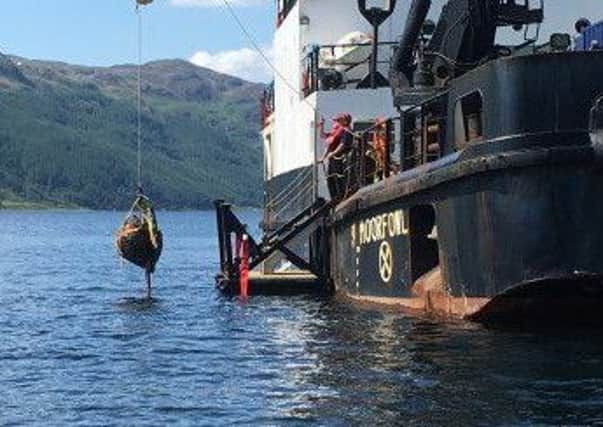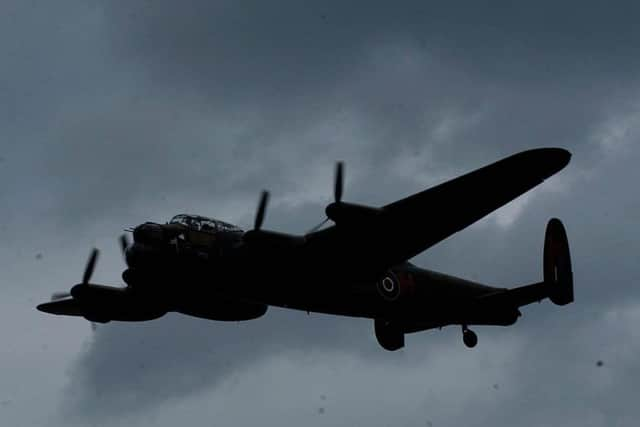'˜Bouncing bombs' from Argyll loch being donated to museums


A specialised piece of underwater scanning equipment was used to locate and identify the ‘Highball bombs’ at Loch Striven in Argyll.
GSE Rentals, part of Unique System UK provided the scanning equipment and engineering support to produce sonar images of the sea bed at the dive site currently being explored by the British Sub-Aqua Club (BSAC).
Advertisement
Hide AdAdvertisement
Hide AdThe scuba divers have completed the daring mission to raise two historic ‘Highball’ bouncing bombs like those used by the Dambusters squadron on the successful raid of the Eder Dam.


Footage of the Highball bombs being tested was used in the WWII film classic, The Dambusters.
The iconic bombs were recovered in perfect condition by divers, thanks to the technical input from Unique Group.
The Dambusters raid, led by Wing Commander Guy Gibson, took place on 16 May 1943, when Lancaster bombers from the RAF’s 617 Squadron dropped the bomb on the Mohne, Sorpe and Eder Dams in the Ruhr Valley.


The aim of the vital operation was to disrupt industry in a key area for the manufacture of Germany’s war munitions.
A smaller bouncing bomb designed to destroy ships was also developed and tested in Scotland. The Highball, also invented by Sir Barnes Wallis, aimed to sink the German battleship Tirpitz, berthed in a Norwegian fjord.
Mosquitos dropped between 120 and 200 of the bombs on Loch Striven, in Argyll. They targeted a disused battleship in the loch ahead of the planned attack on the Tirpitz. The spherical bombs – measuring a metre across – were never used in war and no complete example exists in any museum for display. But millions of people have seen them as footage of bombs skipping over Loch Striven used in the Dambusters movie.
Advertisement
Hide AdAdvertisement
Hide AdMike Osterberger, Unique Group’s senior engineer, said, “We are pleased that the quality of the images allowed us to identify not only a debris field with a number of Highballs but additional debris that we believe to be side charges from the X Craft type submarine.”
The scanner was pulled by a workboat from fellow Scottish company Aspect Surveys. Sub Sea Tooling Services based near Aberdeen also provided an underwater ROV (Remotely Operated Vehicle) to assist with filming the searches.
Around 200 Highballs have lain at the bottom of Loch Striven in Argyll, for almost 75 years since they were tested by the Royal Navy for use against enemy ships and for the Eder Dam raid in the Second World War.
The bombs, which are inactive, were secured by the divers ready for lifting by the Royal Navy and then winched to the surface before being packed, ready for transport in wet tanks containing a special salt-water solution to prevent them from corroding.
Now the aim is to donate the Highballs to two museums so they can be put on display to the public, in time for the 75th anniversary of the Dambusters raid, in 2018.
The Highballs were the naval or anti-ship version of the cylindrical shaped Upkeep bouncing bombs which were used by the Royal Air Force in the actual Dambusters raid in May 1943, both having been designed by Sir Barnes Wallis to bounce over water.
However, it is archive footage of the Highballs being tested at Loch Striven which feature in the 1955 ‘The Dam Busters’ film, as footage of the actual dams bomb used by the RAF was still top secret.
Advertisement
Hide AdAdvertisement
Hide AdMore than 200 of the bombs, codenamed Highball by the military, were tested at Loch Striven.
They were intended to be used on enemy ships but never became operational and they lay scattered on the floor of the loch for three-quarters of a century.The project has received backing from Mary Stopes-Roe the daughter of late British engineer, Sir Barnes Wallis, who invented Britain’s bouncing bombs including the Highballs.